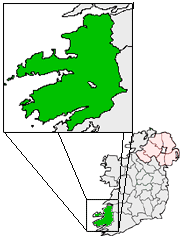 |
| Ann FitzGerald, Priscilla (Barnes) FitzGerald and Polly (FitzGerald) Kimmitt at the original FitzGerald cottage, Farnes, Kerry, Ireland, June 1989 |
My people should never have left Ireland. In so doing they deprived the family forevermore of the healing powers of ferruginous water. I know this because of one tiny phrase in a book with a very long title.
Reading contemporaneous accounts of Ireland helps us to envision ancestral townlands as they were before our families left. A mainstay in every Irish researcher's library is Samuel Lewis' A Topographical Dictionary of Ireland, comprising the several counties, cities, boroughs, corporate, market, and post towns, parishes, and villages, with historical and statistical descriptions; embellished with engravings of the arms of the cities, bishopricks, corporate towns, and boroughs; and of the seals of the several municipal corporations: with an Appendix, describing the electoral boundaries of the several boroughs, as defined by the act of the 2d and 3d of William IV, 2 vols., (London: 1837).
Written about ten years before the Great Famine (1845-1852), it gives the history and lay of the land of every little townland in Ireland. My father (James Patrick/Edmund FitzGerald 1910-1988) always said his father's FitzGerald line were from Castlemaine (Caislean na Mainge) in county Kerry. Castlemaine lies on a harbor at the junction of the Dingle Peninsula and the Ring of Kerry, or just under the first peninsula on the map. It was a market town and the site of a castle built jointly by two Irish chiefs, the Earl of Desmond and MacCarthy More, in order to defend the crossing of the River Maine. Each chief was to alternately protect the castle, but at one point MacCarthy decided he didn't want to give it up. It eventually fell into ruins. Today there is nothing remarkable about the town. A few pubs and bed and breakfast establishments and some fine views are all that distinguish it.
 |
| County Kerry, Ireland |
What my father didn't know was the name of the area in which his family had lived: a little part of Castlemaine called Farnes. He and my mother went over to Ireland in 1978 to visit some of his cousins, and I'm quite sure they went to the house his father was born in, below. By asking the local residents, they managed to find the FitzGerald homestead. Compared to the adjacent older cottage, this was quite a step up for the family. I do wonder how accurate our information was, though. I would imagine that my grandfather, Patrick John FitzGerald (1867-1949) was born in the little cottage and thanks to money he and his siblings sent back to Ireland from the US, the family was able to build this once fine edifice.
 |
| Ann FitzGerald, Myles Kimmitt, Priscilla FitzGerald FitzGerald Homestead, Farnes, Kerry, Ireland, June 1989 |
My mother, sister and I discovered the name when we visited the local parish to view their records in 1989. All of the related FitzGeralds we found lived in Farnes. Farnes is a townland (more like a village or a neighborhood) in the civil parish of Kilgarrylander, and never gets any press. This is understandable. There isn't much there except gorse-covered hills dotted with the occasional cottage.
 |
View of the Slieve Mish (Sliabh Mish) range from FitzGerald home, Farnes, Kerry, Ireland, named after a mythological Celtic princess who was famed for being cruel. |
So there is no historical detail about the actual land my ancestors lived on anywhere, except in one tiny mention in Samuel Lewis' Topographical Dictionary in which he states: "Three miles to the west of the town are the ruins of Castledrum, erected by the sept of Moriarty; and on the lands of Farnass is a good chalybeate spa." What? Peasant farmers living by a spa? Well, this is exciting! Something, at long last to distinguish them from the hordes of peasants the world over. MY ancestors lived near a chalybeate spa. So what is it, then?
The word chalybeate derives originally from the Latin word for steel, "chalybs" which in turn is taken from the Greek "khalups" after those who had invented iron working in Greek mythology. It is simply mineral water that contains iron. Wikipedia has this to say about Chalybeate: "Early in the 17th century, chalybeate water was said to have health-giving properties and many people have promoted its qualities. Dudley North, 3rd Baron North discovered the chalybeate spring at Tunbridge Wells in 1606. Dudley North’s physician claimed that the waters contained ‘vitriol’ and the waters of Tunbridge Wells could cure: the colic, the melancholy, and the vapours; it made the lean fat, the fat lean; it killed flat worms in the belly, loosened the clammy humours of the body, and dried the over-moist brain." It was also said to cure hysteria.
And therein lies the heart of the trouble. By leaving the chalybeatic spa in Farnes (Farnass) my ancestors opened the door to all manner of physiological ills. No wonder some of us are melancholy, some too fat, some too thin. I see it clearly now! This is why my clammy humours are not loosened and my brain remains over-moist. (I do wonder if the roof on the old cottage had anything to do with an abundance of iron in the local water--see first photo.) It is apparent that we must now make an annual trek to the homeland to restore our shattered tissues. I look forward to asking the locals all about it!
 |
| Priscilla (Barnes) FitzGerald Farnes, Kerry, Ireland, June 1989 |

